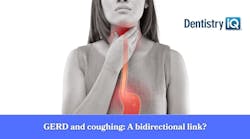Statins and periodontal health: A surprising connection
In 2020, I began treating a patient with severe bone loss and dental mobility due to advanced periodontitis, particularly in the mandibular anterior area. After five years of meticulous periodontal maintenance, I observed an unexpected and remarkable change when comparing the patient’s radiographs: his bone seemed to be slightly regenerating, and mobility was gone. The only significant change in his medical history was the initiation of systemic statins in the last two years.
Curious about this correlation, I started looking into research studies and was surprised to discover that statins have a pleiotropic effect, such as reducing inflammation and enhancing bone regeneration. This article analyzes the current evidence on the effects of subgingivally delivered statins following scaling and root planing and systemic statin use in untreated periodontitis.
Introduction
Hyperlipidemia is defined as a condition characterized by elevated levels of lipids (fats) in the blood, which can increase the risk of cardiovascular disease.1 The lipid that plays a key role in this condition is cholesterol. It is a waxy, fatlike substance present in every cell of the body and is vital for producing hormones, vitamin D, and bile acids that aid in fat digestion. It exists in the bloodstream in two primary forms: low-density lipoprotein (LDL), commonly known as bad cholesterol, that can contribute to plaque buildup in the arteries, and high-density lipoprotein (HDL), referred to as good cholesterol, which helps eliminate LDL from the bloodstream.2
The most common drugs used to treat hyperlipidemia are statins. Statins’ mechanism of action is to inhibit the coenzyme HMG-CoA to lower blood cholesterol levels. Statins are also known to have a pleiotropic effect on oral health; these effects are anti-inflammatory, immunomodulatory, antioxidant, and bone regenerative properties.
On the other hand, periodontitis is a chronic infectious disease affecting the supporting dental tissues caused by pathogens that build up in plaque. It is driven by both microbes and the host's response, resulting in the loss of attachment and alveolar bone. Since there is an association between periodontitis and cardiovascular health, the pleiotropic effects of statins could bring benefits to both conditions.3
When it comes to periodontitis, antimicrobial agents are used to decrease the number of harmful organisms and change their ability to cause disease. The American Dental Association (ADA) practice guidelines recommend localized controlled-release agents as an adjunct therapy to mechanical debridement such as monocycline microspheres (Arestin), doxycyline hyclate gel (Atridox), and chlorhexidine chip (PerioChip). Systemic delivery of antimicrobials can reach a broader spectrum of bacteria, but according to the ADA, there is a small benefit to the use of systemic antibiotics to treat periodontal disease, and they are not recommended due to their higher incidence of adverse effects. They should be considered only in cases of aggressive periodontitis.4 New research introduces statins as an alternative benefit to treat periodontitis in the same way localized antimicrobial agents have been used.
Localized delivery of statins in the periodontium
One systemic review and meta-analysis report assessed the clinical and radiographic effects of subgingivally administered statins after scaling and root planing in patients with periodontitis, including 119 articles and 18 randomized controlled trials with 1,171 participants. Subjects were grouped into systemically healthy patients, smokers, and diabetic patients. The parameters included sulcus bleeding index (SBI), periodontal pocket depth (PD), clinical attachment level gain (CAL), and radiographic infrabony defect depth (IBD). Plaque index (PI) was left out since it had no significant difference across all groups. Drug administration was given at 1.2% gel concentration. Follow-ups were done at three, six, and nine months. Within the statins tested, simvastatin (SMV), atorvastatin (ATV), and rosuvastatin (RSV) had the most significant effects in all groups. All patients tolerated the drug well, experiencing no adverse reactions, discomfort, or complications.
Results
Thirteen out of 18 studies showed significant improvement in SBI after statin use compared to the placebo groups. In healthy patients, ATV improved all parameters, and RSV resulted in significantly higher changes in CAL, PD, and IBD, while SMV improved all but PD and CAL. Two studies were conducted on smokers for at least 10 years; both ATV and SMV showed significant improvement in all parameters. Two other studies conducted on controlled type 2 diabetic patients showed improvement in all parameters in both SMV and ATV groups, with results favoring SMV, but they were not statistically significant.
Four articles compared results of SMV used on healthy patients, controlled diabetic patients, and smokers. Most improvement was seen in healthy patients, although the diabetic group had similar results. The least favorable group to see significant changes was the smoker group.
Comparison of statins and other drugs delivered subgingivally
To examine the effects of statins on the periodontium, a range of studies compared these drugs with nonlipid medications such as alendronate (used to treat and prevent osteoporosis), metformin (used to treat type 2 diabetes), and antimicrobial photodynamic therapy.
- Alendronate 1% vs. atorvastatin 1.2%: Both improved periodontal parameters, but ATV 1.2% yielded higher CAL gains, whereas alendronate 1% showed superior PD and IBD outcomes.
- Metformin 1% vs. rosuvastatin 1.2%: Both enhanced all parameters except radiographic IBD.
- Photodynamic therapy vs. simvastatin 1.2%: SMV demonstrated better results, though not statistically significant.
The systematic review identified certain limitations, including the need for more recent randomized controlled trials, given that the latest one was conducted in 2018. Additionally, 66% of the included studies exhibited a risk of bias.3
Systemic effects of statins in the periodontium
A systemic review on seven studies was analyzed for the efficacy of statins on the periodontium. Three were case-control and four were cross-sectional studies. Each study included at least 70 participants aged 30 and older, all without any comorbidities. In some studies, the drugs administered were ATV and/or SMV, while other studies did not specify. Parameters taken included PI, CAL, PD, gingival index (GI), and bleeding on probing (BOP). Radiographic bone density was excluded. The values that improved with statin use for at least three months included CAL, PD, and BOP. Some studies reported reduced CAL values, enhanced PD in certain groups, and significant reductions in BOP in all groups, indicating potential anti-inflammatory effects of prolonged statin use. However, results varied, with some studies showing no significant differences for certain parameters. Additionally, GI and PI values showed mixed results, and none of the studies have assessed statins’ impact on peri-implant tissues or alveolar bone loss.
Conclusion
Local delivery of statins after scaling and root planing showed advantageous results, while systemic statins presented improvement but no statistical significance. However, the inconsistent findings highlight the necessity for more research, especially concerning peri-implant tissues and alveolar bone loss. Such studies could deepen our understanding of how statins aid in managing periodontitis, therefore improving treatment strategies and patient outcomes.
Editor’s note: This article first appeared in Clinical Insights newsletter, a publication of the Endeavor Business Media Dental Group. Read more articles and subscribe.
References
- Di Spirito F, Schiavo L, Pilone V, Lanza A, Sbordone L, D’Ambrosio F. Periodontal and peri-implant diseases and systemically administered statins: a systematic review. Dent J (Basel). 2021;9(9):100. doi:10.3390/dj9090100
- What is cholesterol? American Heart Association. February 16, 2024. https://www.heart.org/en/health-topics/cholesterol/about-cholesterol
- Greethurst AR, Galletti C, Lo Giudice R, et al. The use of statins as an adjunctive periodontal disease treatment: systematic review and meta-analysis. Dent J (Basel). 2024;12(6):150. doi:10.3390/dj12060150
- Asadoorian J. Antimicrobial agents for the control of periodontal disease. In Bowen D, Pieren J, eds. Dental Hygiene Theory and Practice, 5th ed. Elsevier; 2020:403-413.
About the Author

Jennifer Pettit, CRDH
Jennifer Pettit, CRDH, has over 15 years in the dental field, along with 15 years of expertise in high-level customer service. She is currently pursuing her BAS in dental hygiene. Jennifer practices in Miami, Florida, and also coaches new graduates in office productivity, workflow, and time management. She can be reached at [email protected].



